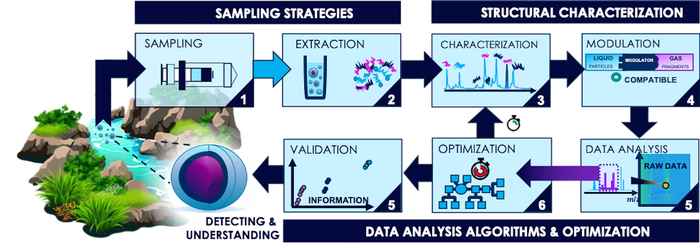STREAMLINED: Improving analytical science to get a grip on nanoplastics
4 July 2025
The project combines the efforts of HIMS analytical scientists Bob Pirok, Alina Astefanei and Ron Peters (also a research scientist at the plastics company Covestro) together with researchers Marja Lamoree and Frederic Béen at the Chemistry for Environment & Health group at Vrije Universiteit Amsterdam (VU). It will involve the appointment of three PhD candidates.
Dubbed STREAMLINED - an acronym for Separation-Technology Research to Effectively Address the Missing Links In Nanoplastics Examination and Detection, the project aims to develop key technology that will allow manufacturers to innovate their materials and regulatory bodies to design meaningful policies. To this end, the consortium includes manufacturing companies (BASF, Covestro, Dow and IFF), instrument manufacturers (GL Sciences and Postnova), and research institutes (TNO and Het Waterlaboratorium). These partners together fund 50% of the total project budget. The consortium also collaborates with a user committee that contains other stakeholders such as the Dutch National Institute for Public Health and the Environment (RIVM) and the companies Ardena and Horiba. The NWO funding was granted as part of the Demand by Consortia – S call within the Knowledge and Innovation Convenant (KIC).
A key technology to address a huge problem

Nanoplastics are potentially harmful to humans and the environment, but currently there are no conclusive approaches for their characterisation and quantitative determination. STREAMLINED addresses this major ‘missing link’ in the innovation cycle for better, safer, and more-sustainable materials. In particular, the project aims to develop the key technology that is required to establish the degradation pathways of plastics and to determine nanoplastics levels in the environment.
Resulting from the important, indispensable role of plastics in modern society, the scale of the problem is huge. It is estimated that about 10% of the 8.3 billion tonnes of plastic ever produced have accumulated in marine and freshwater systems as plastic debris. Both suspended plastic in aquatic systems and terrestrial plastic waste are known to gradually fragment to microplastics and eventually nanoplastics (plastic particles smaller than 1 micrometre). They have been found, amongst others, in drinking water, seafood, sugar, honey and beer, and other food stuffs.
High-throughput analytical method
Research, however, has been mainly exploratory due to the lack of conclusive analytical methods that enable the assessment of environmental and human exposure. STREAMLINED therefore sets out to develop a high-throughput analytical method that combines the assessment of size distribution with polymer identity and mass. It will then be possible to efficiently and reliably measure which kinds and sizes of NPs are present in ecosystems and in what quantities (either in terms of numbers of particles, or in terms of mass). It will also enable the study the formation of nanoparticles from larger plastics, their degradation pathways, and their persistence. The obtained knowledge will ultimately enable the development of new materials that are safer and more sustainable, minimizing nanoparticle formation.
See also
- From nanoplastics to sustainable pension funds: three research consortia launch diverse public-private research projects
- What if you eat nanoplastics? A laboratory exploration of their gastrointestinal digestion
- Chemometrics & Advanced Separations (Research group Bob Pirok)
- Chemistry for Environment & Health (Vrije Universiteit Amsterdam)